What Is A Partially Finished Basement? (Solved!)
When it comes to home improvement, many people are intimidated by the prospect of finishing their basement.
The thought of all that work can be daunting and off-putting for some homeowners and unfortunately, it is often simply put on hold for another day or week.
With that said, though, a partially finished basement is quite common and far from being something to be ashamed of. It can be a great asset to your home; with the right amount of space, you can use it for nearly anything you can. You can turn some strategic investing, including a potential $1000 investment, into a versatile addition, potentially boosting your property’s value in the process.
It can be a great asset to your home – with the right amount of space, you can use it for nearly anything.
In this article I will cover what is a partially finished basement and how you can get started on your home renovation project today!
What Is A Partially Finished Basement?
A partially finished basement is a space that has flooring, walls and ceiling installed but does not have any extraneous pieces.
This can include things like trim work, baseboards, or wainscoting on the walls or flooring.
The addition of these items turns a basement from being just “framed out” into something more usable.
A partially finished basement is valuable because it gives you a blank slate to work from.
You can add any sort of flooring that you like and even create walls or partitions as you see fit.
If your basement has a good ceiling height, then you have already won half the battle – basements typically have lower ceilings than other parts of the house and this can make them feel cramped and claustrophobic.
Types Of Basement Finishing
1. Unfinished Basement
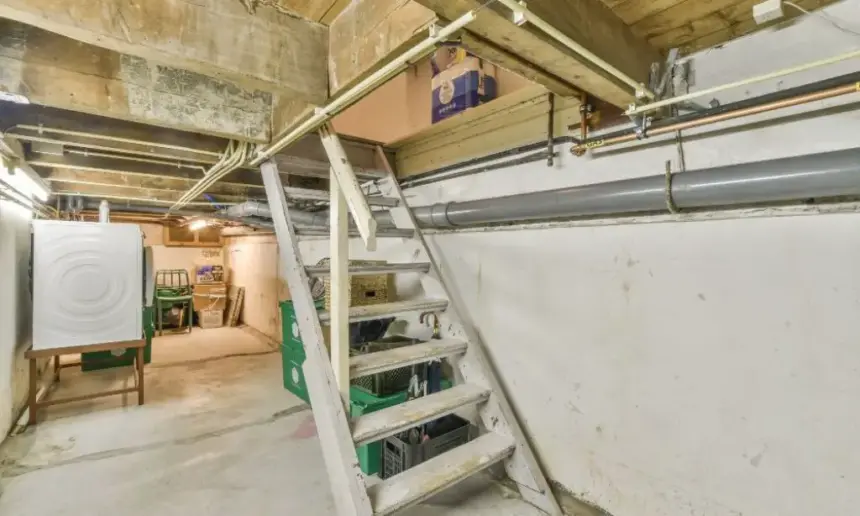
An unfinished basement has not been transformed into any sort of usable space. This type of basement typically has a concrete floor and bare walls.
In some cases, there may be electrical or plumbing work completed in an unfinished basement, but this is not always the case.
An unfinished basement is typically the cheapest and most basic option for finishing this space in your home.
There will be no finished ceilings, walls, or floors in the basement.
The section is neither heated nor cooled in the same way as the rest of the house, and it is mostly utilized as a storage space.
An unfinished basement will have exposed plumbing pipes and electrical wires running along with the ceilings and walls.
The space may also be humid and have a musty smell.
In an unfinished basement, some folks will set up a work area.
The workshop is unlikely to cause any damage to the basement because there are no good finishing touches.
It’s crucial to keep in mind that the temperature in an unfinished basement will not be regulated.
2. Partially Finished Basement
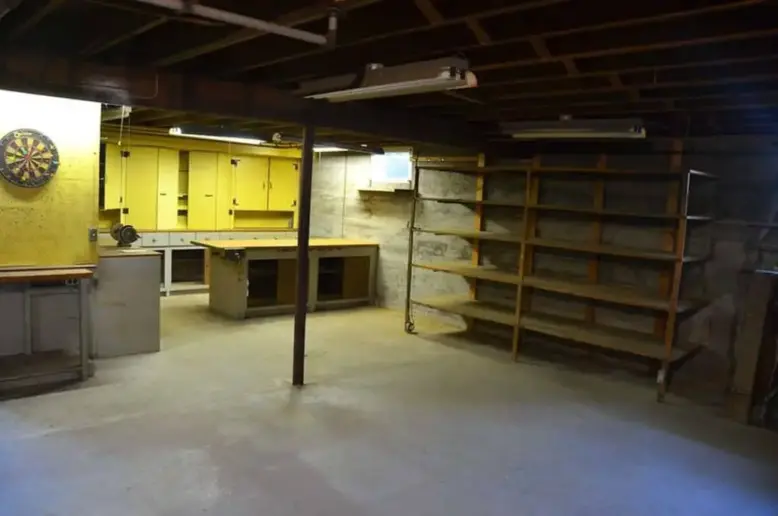
A partially finished basement has had some work done to it but is not quite complete. This could include adding flooring and trim work, as well as walls or partitions.
In some cases, a partially finished basement may also have plumbing or electrical work completed to make the space more functional.
Finishing a basement is expensive, and some people will just finish a portion of their basement due to financial constraints.
Even though these basements aren’t finished, they’re ideal for storing gym equipment, holiday decor, and other items that you don’t need daily but still want to have access to.
The moisture level is one of the things to keep an eye on in a partially finished basement.
Because the temperature in the partially finished basement is unlikely to be managed, moisture can become a concern.
3. Finished Basement
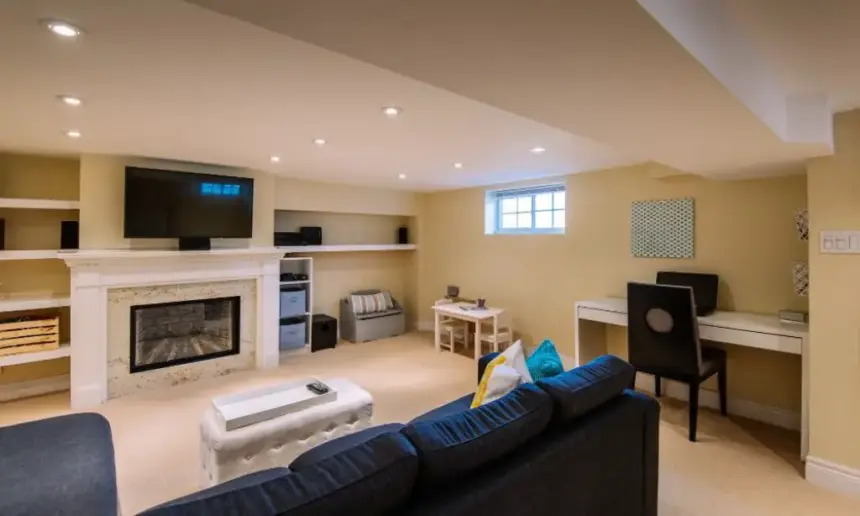
A finished basement has been completely transformed into some sort of usable space, such as a bedroom, family room, or other living areas.
This type of basement finishing typically requires more work than just adding flooring and trim work to the space.
In most cases, it involves extensive amounts of drywall installation and finishing work to make the space livable.
This means you’d notice many of the same conveniences and comforts if you strolled from your utility room into your living room.
It’s a place where you can live and relax.
A finished basement can be used as a recreation space, an office, or even a gym.
To make it feel less like a basement, a finished basement usually has comfortable flooring, heating and cooling equipment, and lighting fixtures.
Innovative lighting solutions can also be adopted. Neon signs are a highly creative and personalized lighting fixture.
It can present various colors and lighting effects and can be customized according to your needs. It can add different atmospheres such as romance, coolness, and liveliness to your basement. Moreover, it is not limited to lighting functions, but can also become decorations and artworks, making your basement more beautiful and unique. You can see more products on NeonSigns.com.
A completed basement is a fantastic addition to any home, and it will almost certainly raise the value of the property.

Can You Live In A Partially Finished Basement?
A partially finished basement can be livable, but it is important to consider a few things first.
If you are planning on finishing your basement yourself, then you need to make sure that the space is up to code.
This means that it needs to have proper egress in case of fire, as well as adequate ventilation and lighting.
If you are not comfortable with electrical or plumbing work, then you should hire a professional to help you get the space up to code.
Another thing to consider is the appearance of the space.
A partially finished basement will not have the same level of finish as the rest of your house and this can be a bit of an adjustment for some people.
You may want to consider putting in a carpet or flooring that will help to make the space more comfortable and inviting.
How To Finish A Partially Finished Basement
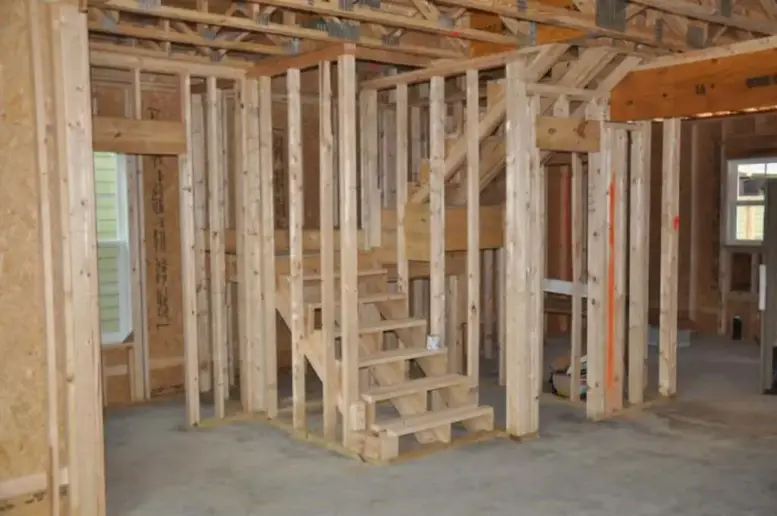
1. Assess The Requirements For Completion
If you have a partially finished basement, the first step is to assess what needs to be done to complete the space.
This will vary depending on your personal preferences and the amount of money that you are willing to invest in the project.
In some cases, all you may need to do is add flooring and trim work to achieve the look that you desire.
In other cases, you may need to do a bit more work to make the space livable.
This could include adding walls or partitions, insulation, or even plumbing or electrical work.
2. Consult With A Professional
They can help you to assess the space and determine what needs to be done to complete the project.
They can also give you an estimate of the cost and time required to finish the job.
In most cases, finishing a partially finished basement is something that you can do fairly quickly, provided that you have the money to do it.
It is always a good idea to consult with a professional before committing to the project, as they will be able to provide you with accurate estimates so that you are prepared for the costs involved in completing this home improvement job.
3. Choose The Right Materials
There are several different materials that you can use to finish your basement.
The type of material that you choose will depend on your budget, the look that you want to achieve, and the functionality of the space.
Some common materials for basement finishing include drywall, plywood panels, textured wallboard, or even vinyl flooring.
4. Install The Materials Carefully
Once you have decided on a material for each part of your basement finishing project, it is important to install them carefully.
This is particularly true for materials like drywall or textured wallboard, which can be difficult to work with.
In most cases, it is best to hire a professional to help you with the installation of these materials so that they are installed correctly and will not cause any problems down the road.
When Is A Basement Considered Finished?
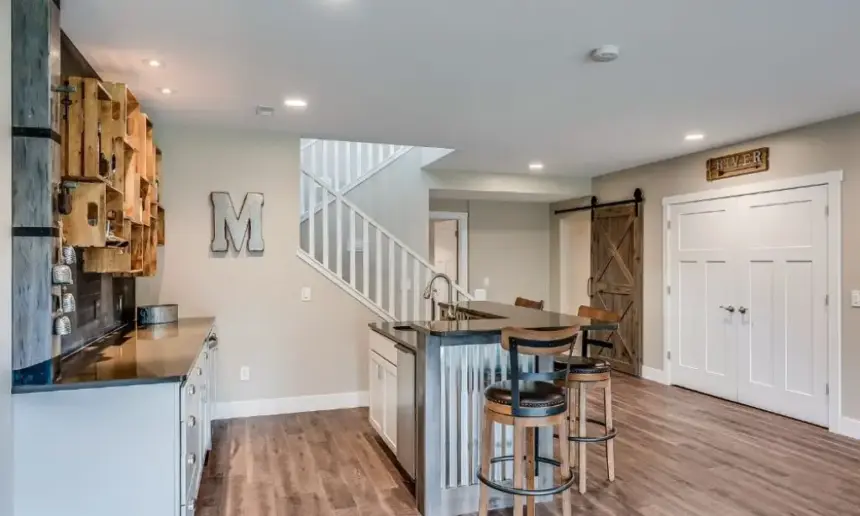
The level of finish in a basement can vary widely from home to home.
In some homes, the basement may be little more than an unfinished storage space, while in others, the basement may be a beautifully finished living area complete with all the amenities of any other room in the house.
So when is a basement considered finished?
Finished Basement Requirements
Some basements are a bit borderline when it comes to whether or not they are finished or not.
To be considered a finished basement, certain requirements need to be met.
These can typically be determined by a home inspector or other professional who is familiar with local building codes.
A general rule of thumb is that a basement is considered finished if it meets the following criteria:
1. The Basement Has Drywall Installed On The Walls And Ceiling
The walls are painted a neutral color to allow for the homeowner’s preferences in decoration, the ceiling is drywalled and does not need any attention at this time.
And the floor has a comfortable and attractive surface that is conducive to moving around in the space, such as tile or carpet.
2. The Flooring Is Completely Done
The floor has a comfortable and attractive surface that is conducive to moving around in the space, such as tile or carpet, and there is no exposed concrete, insulation, or other unsightly materials.
3. There Is Adequate Lighting In The Space
The basement has windows that let in natural light, or the basement has artificial lighting that is bright enough to see clearly throughout the space.
Also any electrical fixtures are properly installed and working.
4. The Basement Has Proper Ventilation
The basement has one or more windows that can be opened to allow for fresh air circulation, or the basement has an exhaust fan to help remove any stale air present in the space.
There is adequate insulation to prevent moisture from building up in the basement and affecting the structural integrity of the home.
In other cases, air conditioning gadgets may also be installed to help improve the air quality in the basement.
5. There Is A Functioning Bathroom And Kitchen In The Basement
The basement has a bathroom that is up to code and functional. This may include a toilet, sink, shower, or bathtub.
And The basement has a kitchen that is up to code and functional. This may include a sink, stove, and refrigerator.
Also any other required appliances, such as a washing machine and dryer, are properly installed and operational.
6. The Space Is Heated And Cooled
Typically, a basement is heated and cooled using the same equipment that heats and cools the main level of a house.
In some cases, there may be additional heating and cooling equipment installed in the basement to help keep it comfortable throughout the year.
The temperature of the basement should generally be at least as warm as that of the main level. This can be accomplished with an HVAC system or a space heater in colder weather.
7. The Basement Has Sufficient Electrical Outlets And Wiring
The basement is fully wired and has enough electrical outlets to meet the needs of the space.
This may include outlets for appliances, lighting, and any other electronics that will be used in the space.
The wiring is up to code and safe for use and the basement has access to a main electrical panel that is large enough for all the required wiring and outlets.
8. Exit Doors Are Properly Installed
The basement has at least two exit doors that are up to code and can be easily opened in case of an emergency.
The exit doors lead to a safe area outside of the home, such as a driveway or sidewalk.
9. The Basement Is Free Of Pests
The basement has been treated for any pests that may be present, such as termites, rats, or mice.
And any cracks or holes in the walls or foundation have been filled and sealed to prevent pests from moving inside.
Conclusion
In this article, I have covered what is a partially finished basement, as well as some of the key elements that make up this type of space.
A partially finished basement is a great space to use for a variety of purposes, from additional living space to storage.
To ensure that your basement is truly functional and ready for use, it should be properly finished with drywall, flooring, lighting, ventilation, and other features as needed.
By following the tips in this article, you can ensure that your basement is up to code and meets all of the requirements for use.
If you have any questions or concerns about finishing your basement, be sure to consult with a professional contractor to get started.



















































































